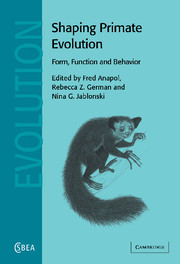Book contents
- Frontmatter
- Contents
- List of contributors
- Preface: shaping primate evolution
- 1 Charles Oxnard: an appreciation
- Part I Craniofacial form and variation
- Part II Organ structure, function, and behavior
- Part III In vivo organismal verification of functional models
- 11 Jaw adductor force and symphyseal fusion
- 12 Hind limb drive, hind limb steering? Functional differences between fore and hind limbs in chimpanzee quadrupedalism
- Part IV Theoretical models in evolutionary morphology
- Part V Primate diversity and evolution
- Index
- References
11 - Jaw adductor force and symphyseal fusion
Published online by Cambridge University Press: 10 August 2009
- Frontmatter
- Contents
- List of contributors
- Preface: shaping primate evolution
- 1 Charles Oxnard: an appreciation
- Part I Craniofacial form and variation
- Part II Organ structure, function, and behavior
- Part III In vivo organismal verification of functional models
- 11 Jaw adductor force and symphyseal fusion
- 12 Hind limb drive, hind limb steering? Functional differences between fore and hind limbs in chimpanzee quadrupedalism
- Part IV Theoretical models in evolutionary morphology
- Part V Primate diversity and evolution
- Index
- References
Summary
Introduction
Research over the last 25–30 years has revealed a considerable amount about the basic mechanisms of mammalian mastication (e.g., van Eijden and Turkawski, 2001; Türker, 2002). This progress has been largely due to the development of new experimental procedures and techniques. On the other hand, there has been relatively little emphasis on employing these procedures and techniques so as to facilitate adaptive explanations for the evolution of the mammalian masticatory apparatus (Herring, 1993). It has been our intent over the last several years to do just that (Ross and Hylander, 1996; Hylander et al., 1998, 2000, 2002, 2003; Ravosa et al., 2000; Vinyard et al., 2001, in press a; Wall et al., 2002; Williams et al., 2003). In recent years the functional morphology of the craniofacial region of primates and other mammals has attracted a significant amount of research interest (Weijs, 1994; Ross and Hylander, 1996, 2000; Spencer, 1998; Anapol and Herring, 2000; Daegling and Hylander, 2000; Dechow and Hylander, 2000; Herring and Teng, 2000; Hylander et al., 2000; Lieberman and Crompton, 2000; Ravosa et al., 2000). This is simply because there continue to be many unanswered research questions or problems. One persistent problem that has received a considerable amount of attention is related to the adaptive significance of symphyseal fusion in mammals. As noted by many, the ossification or fusion of the left and right sides of the lower jaw or dentaries has occurred independently in many different mammalian lineages (e.g., Beecher, 1977).
- Type
- Chapter
- Information
- Shaping Primate EvolutionForm, Function, and Behavior, pp. 229 - 257Publisher: Cambridge University PressPrint publication year: 2004
References
- 42
- Cited by



